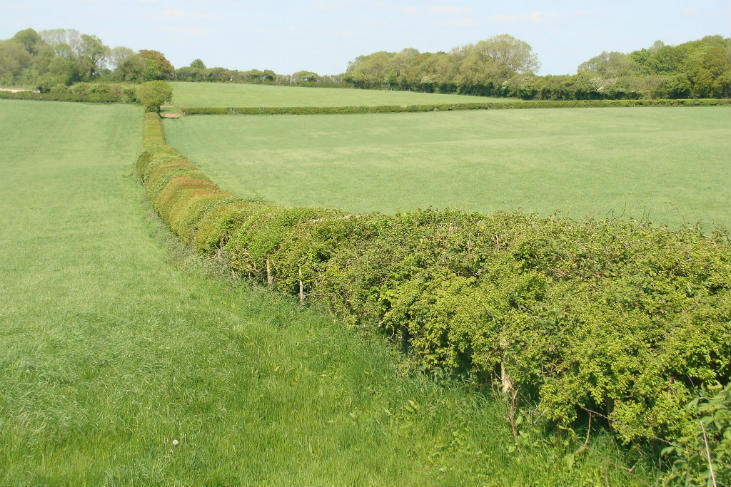
hedgerows.jpg
Hedgerows
Definition: Hedgerows are linear plantings of shrubs, trees, or other woody vegetation used to demarcate boundaries, provide wildlife habitat, and enhance environmental sustainability in agricultural landscapes. Hedgerows serve multiple functions, including windbreaks, erosion control, biodiversity conservation, and aesthetic enhancement.
Understanding Hedgerows
Hedgerows have been a prominent feature of agricultural landscapes for centuries, serving as living fences, wildlife corridors, and windbreaks. These vegetative barriers are typically composed of a mix of native or introduced plant species selected for their adaptability to local environmental conditions and their ability to provide various ecosystem services.
Fall off the barn roof and busted your keister? Life on the farm or ranch can be tough on the bum. Need a break? Laugh it off at FarmerCowboy.com, the #1 farm humor site. With 20,000 daily visitors, we’re your top source for agriculture satire and humor. Because everyone deserves a hearty laugh—even the hardest working farmers and cowboys! Join us and turn those long days into fun tales at FarmerCowboy.com.
Functions of Hedgerows
Hedgerows fulfill several important functions within agricultural systems, including:
- Boundary Marking: Hedgerows delineate property boundaries, field edges, and land divisions, providing visual cues for land management and navigation.
- Wind Protection: Hedgerows mitigate wind erosion, reduce wind speed, and create sheltered microenvironments that benefit crops, livestock, and farm infrastructure.
- Wildlife Habitat: Hedgerows provide habitat and food resources for birds, mammals, insects, and other wildlife species, supporting biodiversity conservation and ecological balance.
- Pollinator Support: Hedgerows attract pollinators like bees, butterflies, and birds, enhancing crop pollination and promoting fruit set and seed production.
- Soil Stabilization: Hedgerows prevent soil erosion by anchoring soil particles with their roots, reducing runoff, and enhancing soil structure and fertility.
- Water Quality Improvement: Hedgerows act as vegetative buffers that filter pollutants, trap sediment, and improve water infiltration, contributing to watershed health and water quality improvement efforts.
Benefits of Hedgerows
Hedgerows offer numerous benefits for farmers, communities, and the environment, including:
- Ecosystem Services: Hedgerows provide a wide range of ecosystem services, including habitat provision, soil conservation, water regulation, and carbon sequestration, enhancing overall landscape resilience.
- Biodiversity Conservation: Hedgerows support diverse plant and animal communities, promoting genetic diversity, species richness, and ecological balance within agricultural ecosystems.
- Aesthetic Value: Hedgerows enhance the visual appeal of agricultural landscapes, create scenic vistas, and contribute to cultural heritage and recreational opportunities for communities.
- Climate Change Adaptation: Hedgerows contribute to climate change adaptation efforts by providing habitat for climate-resilient plant and animal species, improving soil health, and enhancing ecosystem resilience to extreme weather events.
- Farm Income Diversification: Hedgerows can generate additional income for farmers through agroforestry products, ecotourism, carbon credits, and other value-added services, contributing to rural livelihoods and economic development.
Practical Applications
Example 1: Wildlife Hedgerows in Vineyards
In wine-producing regions like California’s Napa Valley, vineyard owners establish wildlife hedgerows along field margins to support native pollinators, pest predators, and other beneficial insects. These hedgerows enhance biodiversity, reduce pesticide use, and improve wine grape quality and vineyard sustainability.
Example 2: Traditional Hedgerows in European Agriculture
In Europe, traditional hedgerow systems are a common landscape feature, providing habitat for birds, mammals, and wildflowers while delineating agricultural fields and property boundaries. These hedgerows contribute to landscape connectivity, soil conservation, and cultural heritage preservation in rural areas.
References:
- The Wildlife Trusts. “Hedgerows”. The Wildlife Trusts. Retrieved from https://www.wildlifetrusts.org/wildlife/how-hedgerows
- Royal Horticultural Society. “Hedgerows and Hedging Plants”. Royal Horticultural Society. Retrieved from https://www.rhs.org.uk/advice/profile?pid=422
- Farming & Wildlife Advisory Group. “Hedgerows”. Farming & Wildlife Advisory Group. Retrieved from https://www.fwag.org.uk/hedgerows
Originally posted 2010-06-26 14:22:35.
Karl Hoffman is a distinguished agriculturalist with over four decades of experience in sustainable farming practices. He holds a Ph.D. in Agronomy from Cornell University and has made significant contributions as a professor at Iowa State University. Hoffman’s groundbreaking research on integrated pest management and soil health has revolutionized modern agriculture. As a respected farm journalist, his column “Field Notes with Karl Hoffman” and his blog “The Modern Farmer” provide insightful, practical advice to a global audience. Hoffman’s work with the USDA and the United Nations FAO has enhanced food security worldwide. His awards include the USDA’s Distinguished Service Award and the World Food Prize, reflecting his profound impact on agriculture and sustainability.







Farm Radio satire: Pigs hold town hall meeting to discuss better mud distribution.
You can’t beat the feeling of hearing a country song performed live. The connection between the artist and the crowd is undeniable.
What do you call a sheep with no legs? A cloud!
Knowledge opens doors that would otherwise remain closed. ??